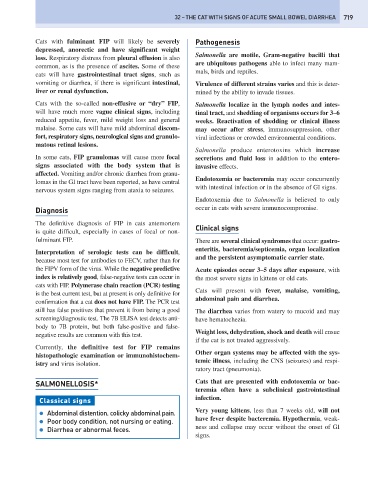Page 727 - Problem-Based Feline Medicine
P. 727
32 – THE CAT WITH SIGNS OF ACUTE SMALL BOWEL DIARRHEA 719
Cats with fulminant FIP will likely be severely Pathogenesis
depressed, anorectic and have significant weight
Salmonella are motile, Gram-negative bacilli that
loss. Respiratory distress from pleural effusion is also
are ubiquitous pathogens able to infect many mam-
common, as is the presence of ascites. Some of these
mals, birds and reptiles.
cats will have gastrointestinal tract signs, such as
vomiting or diarrhea, if there is significant intestinal, Virulence of different strains varies and this is deter-
liver or renal dysfunction. mined by the ability to invade tissues.
Cats with the so-called non-effusive or “dry” FIP, Salmonella localize in the lymph nodes and intes-
will have much more vague clinical signs, including tinal tract, and shedding of organisms occurs for 3–6
reduced appetite, fever, mild weight loss and general weeks. Reactivation of shedding or clinical illness
malaise. Some cats will have mild abdominal discom- may occur after stress, immunosuppression, other
fort, respiratory signs, neurological signs and granulo- viral infections or crowded environmental conditions.
matous retinal lesions.
Salmonella produce enterotoxins which increase
In some cats, FIP granulomas will cause more focal secretions and fluid loss in addition to the entero-
signs associated with the body system that is invasive effects.
affected. Vomiting and/or chronic diarrhea from granu-
Endotoxemia or bacteremia may occur concurrently
lomas in the GI tract have been reported, as have central
with intestinal infection or in the absence of GI signs.
nervous system signs ranging from ataxia to seizures.
Endotoxemia due to Salmonella is believed to only
Diagnosis occur in cats with severe immunocompromise.
The definitive diagnosis of FIP in cats antemortem
Clinical signs
is quite difficult, especially in cases of focal or non-
fulminant FIP. There are several clinical syndromes that occur: gastro-
enteritis, bacteremia/septicemia, organ localization
Interpretation of serologic tests can be difficult,
and the persistent asymptomatic carrier state.
because most test for antibodies to FECV, rather than for
the FIPV form of the virus. While the negative predictive Acute episodes occur 3–5 days after exposure, with
index is relatively good, false-negative tests can occur in the most severe signs in kittens or old cats.
cats with FIP. Polymerase chain reaction (PCR) testing
Cats will present with fever, malaise, vomiting,
is the best current test, but at present is only definitive for
abdominal pain and diarrhea.
confirmation that a cat does not have FIP. The PCR test
still has false positives that prevent it from being a good The diarrhea varies from watery to mucoid and may
screening/diagnostic test. The 7B ELISA test detects anti- have hematochezia.
body to 7B protein, but both false-positive and false-
Weight loss, dehydration, shock and death will ensue
negative results are common with this test.
if the cat is not treated aggressively.
Currently, the definitive test for FIP remains
Other organ systems may be affected with the sys-
histopathologic examination or immunohistochem-
temic illness, including the CNS (seizures) and respi-
istry and virus isolation.
ratory tract (pneumonia).
SALMONELLOSIS* Cats that are presented with endotoxemia or bac-
teremia often have a subclinical gastrointestinal
infection.
Classical signs
Very young kittens, less than 7 weeks old, will not
● Abdominal distention, colicky abdominal pain.
have fever despite bacteremia. Hypothermia, weak-
● Poor body condition, not nursing or eating.
ness and collapse may occur without the onset of GI
● Diarrhea or abnormal feces.
signs.

